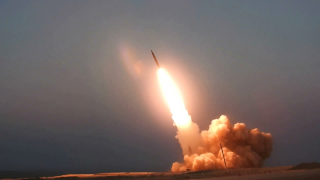Could "Smart" Hypersonic Missiles be in America's Future?
The Pentagon is looking to engineer self-guiding hypersonic weapons with emerging levels of autonomy to quickly adjust course in flight as needed, adapt to emerging targets and avoid defensive threats.
Here's What You Need To Remember: Enabling missiles traveling at hypersonic speeds to draw upon advanced sensors and guidance technology could, for instance, enable an attack to rapidly adjust to an enemy countermeasure, destroy an approaching interceptor or even alter its trajectory to avoid any impediments to attack.
The Pentagon is looking to engineer self-guiding hypersonic weapons with emerging levels of autonomy to quickly adjust course in flight as needed, adapt to emerging targets and avoid defensive threats.
Of course, humans would make the necessary command and control decisions when it comes to the use of lethal force, per existing Pentagon doctrine. Yet enabling missiles traveling at hypersonic speeds to draw upon advanced sensors and guidance technology could, for instance, enable an attack to rapidly adjust to an enemy countermeasure, destroy an approaching interceptor or even alter its trajectory to avoid any impediments to attack.
This kind of technical focus, mentioned by the Pentagon’s Principal Director for Hypersonics Michael White, seeks to build upon fast emerging progress in the area of autonomy.
“So you can think of autonomy and hypersonics being integrated in the way you fly vehicles and the things you might do with those vehicles,” White told reporters according to a Pentagon transcript.
This kind of technology already exists to a large degree, as sensors and guidance systems enabled by advanced computer algorithms can detect and respond to moving objects to help drones, aircraft and even some weapons systems rapidly change course in response to threat information. Tomahawk missiles, for example, can now use advanced sensing and data link technology to shift in flight to destroy moving targets at sea. This development, taking place through the Navy’s Tactical Maritime Tomahawk program, massively changes attack options for commanders at sea by increasing the range and precision with which they can attack enemy ships. By extension, the Navy’s SM-6 missile is now engineered with software upgrades enabling a “dual mode” seeker which can send its own electromagnetic “ping” forward to discern shifting targets.
Why couldn’t some of these guidance systems be adapted to hypersonic weapons moving at much faster speeds? The answer seems to be they probably could be, which might explain why White is emphasizing the integration of more autonomy into hypersonics. Engineering guidance and seeker technology capable of functioning at those speeds could pose technical challenges, as sensor technologies would need to operate successfully while moving at five-times the speed of sound where high-temperatures can create problems for technical functionality. Also, with the speed of warfare moving that quickly, autonomous hypersonic weapons would rely upon much faster computer processing speeds wherein technical systems could make calculations in milliseconds.
In addition to autonomous attack guidance, White also stressed the role of autonomy when it comes to “defense against adversary hypersonics,” meaning advanced algorithms could be employed on things like satellites or interceptor missiles. With this in mind, White referred to ongoing work with the Missile Defense Agency to refine and improve new defenses. This could apply to the use of advanced algorithms on kill vehicle interceptors increasingly able to discern decoys and countermeasures from actual threats. It is likely that there will be some new ways to synergize satellite sensors with emerging kill vehicle technology, as the technical ability to track multiple approaching threats at one time has existed for several years now and the Pentagon is working quickly and intensely on expanding satellite sensing capability.
Kris Osborn is Defense Editor for the National Interest. Osborn previously served at the Pentagon as a Highly Qualified Expert with the Office of the Assistant Secretary of the Army—Acquisition, Logistics & Technology. Osborn has also worked as an anchor and on-air military specialist at national TV networks. He has appeared as a guest military expert on Fox News, MSNBC, The Military Channel, and The History Channel. He also has a Masters Degree in Comparative Literature from Columbia University.
This article first ran a few months ago and is being reposted due to reader interest.
Image: Reuters

